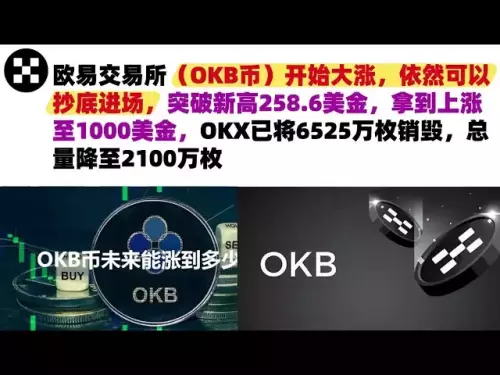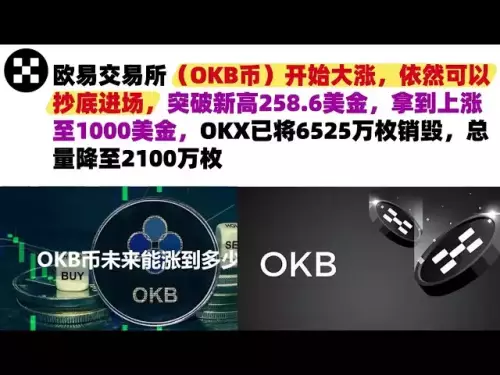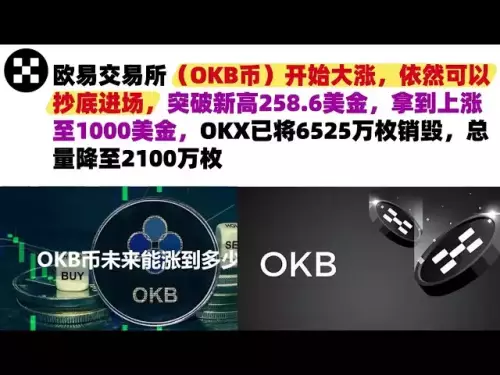-
 Bitcoin
Bitcoin $108600
-1.14% -
 Ethereum
Ethereum $4395
1.43% -
 Tether USDt
Tether USDt $1.000
0.01% -
 XRP
XRP $2.807
-2.26% -
 BNB
BNB $859.9
0.55% -
 Solana
Solana $202.7
-2.19% -
 USDC
USDC $0.9999
0.01% -
 Dogecoin
Dogecoin $0.2160
1.00% -
 TRON
TRON $0.3403
0.22% -
 Cardano
Cardano $0.8321
1.26% -
 Chainlink
Chainlink $23.37
0.14% -
 Hyperliquid
Hyperliquid $43.58
-1.63% -
 Ethena USDe
Ethena USDe $1.001
0.02% -
 Sui
Sui $3.332
1.21% -
 Stellar
Stellar $0.3574
-1.80% -
 Cronos
Cronos $0.3183
8.00% -
 Bitcoin Cash
Bitcoin Cash $531.9
-0.94% -
 Avalanche
Avalanche $23.57
-0.77% -
 Hedera
Hedera $0.2246
-1.56% -
 UNUS SED LEO
UNUS SED LEO $9.500
-1.19% -
 Litecoin
Litecoin $110.7
0.46% -
 Toncoin
Toncoin $3.094
1.40% -
 Shiba Inu
Shiba Inu $0.00001239
1.64% -
 Uniswap
Uniswap $9.725
1.76% -
 Polkadot
Polkadot $3.789
-0.38% -
 Dai
Dai $0.0000
0.01% -
 Bitget Token
Bitget Token $4.553
0.26% -
 Monero
Monero $267.4
1.42% -
 Aave
Aave $316.2
2.80% -
 Ethena
Ethena $0.6706
3.38%
What is a perpetual swap in crypto?
Perpetual swaps allow traders to speculate on crypto prices indefinitely without expiration, using leverage and funding rates to align with spot markets.
Aug 30, 2025 at 12:55 am
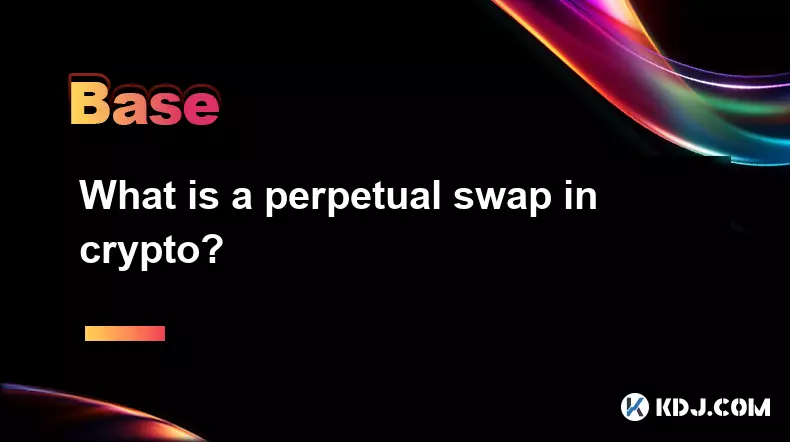
Understanding Perpetual Swaps in the Cryptocurrency Market
1. A perpetual swap is a type of derivative contract that allows traders to speculate on the price of a cryptocurrency without owning the underlying asset. Unlike traditional futures contracts, perpetual swaps do not have an expiration date, enabling traders to hold positions indefinitely. This structure makes them particularly attractive for both short-term and long-term trading strategies.
2. These contracts are primarily used on centralized and decentralized derivatives exchanges such as BitMEX, Bybit, and dYdX. Traders can go long (bet on price increases) or short (bet on price decreases) using leverage, which amplifies both potential gains and losses. Leverage options often range from 2x to as high as 100x, depending on the platform and the asset.
3. The absence of an expiry means that funding rates play a crucial role in maintaining the contract price close to the spot market price. Funding is exchanged periodically between long and short position holders. If the perpetual swap trades above the spot price, longs pay shorts; if below, shorts pay longs. This mechanism helps align the contract value with real market conditions.
4. Perpetual swaps are typically settled in cryptocurrency, often in stablecoins like USDT or the base asset itself. This design facilitates seamless trading across borders and platforms, contributing to their widespread adoption in the crypto trading community.
5. Risk management is essential when trading perpetual swaps due to the high volatility of digital assets and the use of leverage. Liquidation occurs when a trader’s margin falls below the maintenance threshold, resulting in the automatic closure of the position. Understanding liquidation prices and using stop-loss orders are critical for preserving capital.
Mechanics Behind Funding Rates
1. Funding rates are periodic payments exchanged between traders on perpetual swap markets to anchor the contract price to the underlying asset’s spot price. These rates are calculated based on the difference between the perpetual contract price and the index price, which is derived from major spot exchanges.
2. The frequency of funding payments varies by platform—common intervals include every 8 hours on Bybit and every hour on some DeFi protocols. The rate is usually a small percentage, but it can fluctuate significantly during periods of high demand for long or short positions.
3. When the market is bullish and more traders open long positions, the perpetual swap price tends to trade at a premium. In such cases, the funding rate becomes positive, meaning longs pay shorts. Conversely, in bearish conditions with more short positions, the rate turns negative, and shorts pay longs.
4. Traders can use funding rates as a sentiment indicator. Consistently high positive funding may signal over-leveraged long positions, potentially increasing the risk of a sharp downward correction. Negative funding over extended periods may indicate strong bearish sentiment.
5. Some traders employ funding rate arbitrage strategies, opening opposing positions in the spot and perpetual markets to capture funding payments while remaining market-neutral. This approach requires careful monitoring of fees and slippage to remain profitable.
Risks and Rewards of Leveraged Trading
1. The primary appeal of perpetual swaps lies in the ability to control large positions with relatively small capital due to leverage. A 10x leverage allows a trader to control $10,000 worth of an asset with only $1,000 in margin. This magnifies profit potential when market movements align with the trader’s position.
2. However, leverage also increases the risk of liquidation. A small adverse price move can trigger automatic position closure, especially in volatile markets. For example, a 5% price move against a 20x leveraged position can result in total loss of margin.
3. Traders must monitor their maintenance margin requirements closely, as exchanges enforce these rules strictly to cover potential losses. Different platforms display liquidation prices and margin ratios in real time, helping users manage exposure.
4. High leverage can lead to cascading liquidations during extreme volatility, which may exacerbate price swings. This phenomenon, known as a 'long squeeze' or 'short squeeze,' occurs when mass liquidations trigger further price movements in the same direction.
5. Despite the risks, perpetual swaps offer advanced trading tools such as take-profit, stop-loss, and trailing stops. These features allow traders to automate risk management and protect profits without constant monitoring.
Popular Platforms Offering Perpetual Swaps
1. Bybit is one of the largest platforms for perpetual swap trading, supporting a wide range of cryptocurrencies including Bitcoin, Ethereum, and various altcoins. It offers up to 100x leverage and uses USDT-margined contracts, making it accessible to a global user base.
2. Binance Futures provides both USDT-margined and coin-margined perpetual contracts with deep liquidity and advanced charting tools. Its integration with the broader Binance ecosystem allows seamless fund transfers and access to a vast trading community.
3. dYdX operates as a decentralized exchange using smart contracts on Ethereum and StarkEx. It offers permissionless trading with up to 20x leverage and emphasizes transparency and non-custodial security.
4. BitMEX pioneered the perpetual swap concept in 2016 and remains influential in the space. Although it has faced regulatory challenges, it continues to serve a dedicated user base with innovative contract designs.
5. Each platform has unique fee structures, leverage limits, and collateral options, requiring traders to evaluate which best suits their strategy and risk tolerance.
Frequently Asked Questions
What determines the funding rate on a perpetual swap?Funding rates are determined by the price difference between the perpetual contract and the underlying spot index. They are also influenced by market demand for long or short positions and are recalculated at regular intervals set by the exchange.
Can I trade perpetual swaps without leverage?Yes, traders can open perpetual swap positions with 1x leverage, effectively mimicking a spot trade while still benefiting from features like shorting and funding rate exposure. This approach reduces liquidation risk while maintaining flexibility.
How is a perpetual swap different from a futures contract?The key difference is that futures contracts have an expiration date and require settlement, while perpetual swaps do not expire and are kept in line with spot prices through funding mechanisms. This allows traders to hold positions indefinitely.
Are perpetual swaps available for all cryptocurrencies?No, perpetual swaps are typically offered for major cryptocurrencies with sufficient liquidity, such as BTC, ETH, and top altcoins. Availability depends on the exchange and market demand for derivatives on a given asset.
Disclaimer:info@kdj.com
The information provided is not trading advice. kdj.com does not assume any responsibility for any investments made based on the information provided in this article. Cryptocurrencies are highly volatile and it is highly recommended that you invest with caution after thorough research!
If you believe that the content used on this website infringes your copyright, please contact us immediately (info@kdj.com) and we will delete it promptly.
- DeFi's Golden Age: How Polygon's USDT/XAU Integration Ushers in a New Era
- 2025-08-30 17:05:12
- Plasma, EtherFi, and Stablecoin Yields: A New Era of DeFi?
- 2025-08-30 16:45:21
- Remittix (RTX): The Real-World Utility Kingpin and Its Market Positioning in 2025
- 2025-08-30 17:25:15
- Succinct, Institutional Liquidity, and Strategic Investment: Decoding the Future of Blockchain
- 2025-08-30 16:45:21
- Dogecoin, BONK, and the Price Dip Tango: What's Shakin'?
- 2025-08-30 17:30:12
- XRP, Institutional Adoption, and Treasury Yield: A New Era?
- 2025-08-30 17:30:12
Related knowledge
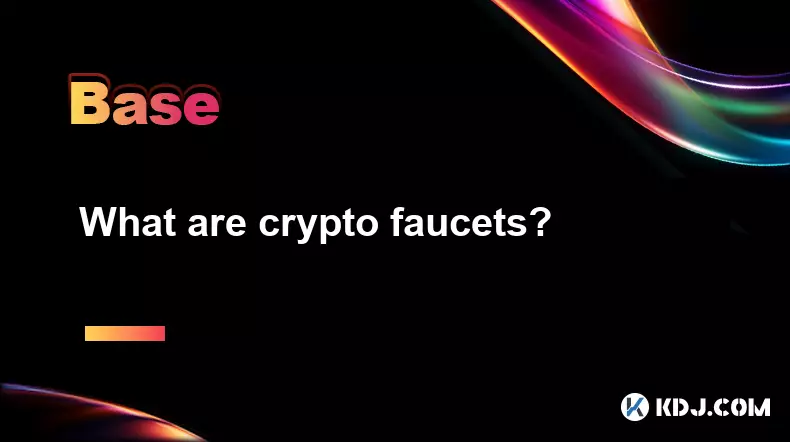
What are crypto faucets?
Aug 30,2025 at 08:10am
Understanding Crypto Faucets1. Crypto faucets are online platforms that distribute small amounts of cryptocurrency to users for completing simple task...

What are privacy coins?
Aug 30,2025 at 06:18am
Understanding Privacy Coins in the Cryptocurrency Ecosystem1. Privacy coins are a category of cryptocurrencies specifically designed to enhance transa...
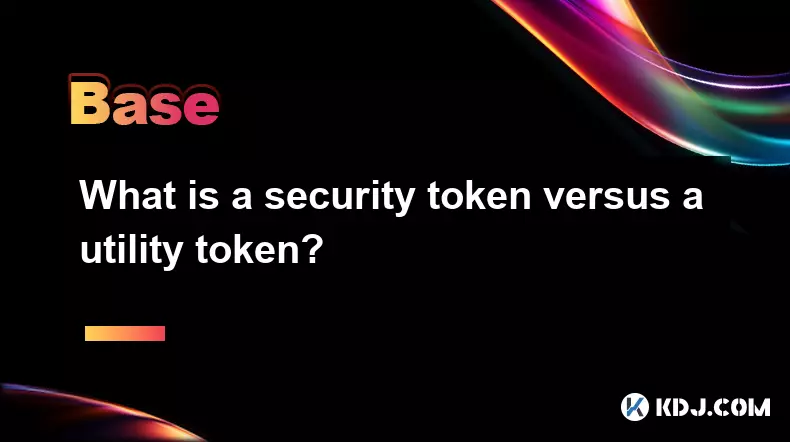
What is a security token versus a utility token?
Aug 30,2025 at 03:00pm
Understanding Security Tokens1. Security tokens represent ownership in an external asset or enterprise, often resembling traditional financial instrum...

What is a perpetual swap in crypto?
Aug 30,2025 at 12:55am
Understanding Perpetual Swaps in the Cryptocurrency Market1. A perpetual swap is a type of derivative contract that allows traders to speculate on the...
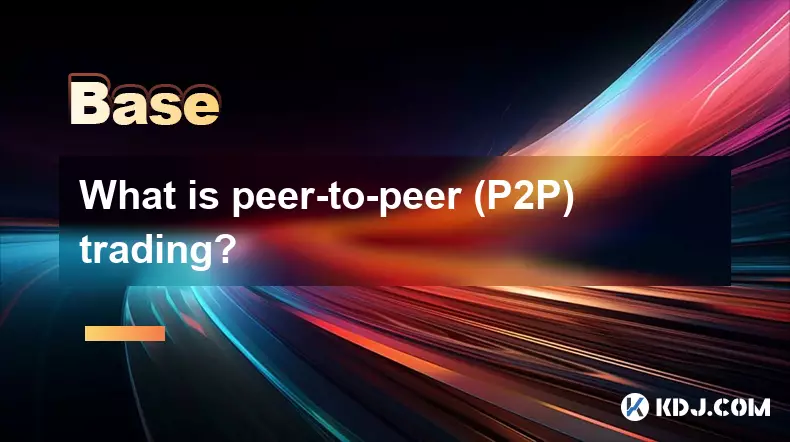
What is peer-to-peer (P2P) trading?
Aug 29,2025 at 11:00pm
Understanding Peer-to-Peer (P2P) Trading in the Cryptocurrency Ecosystem1. Peer-to-peer (P2P) trading refers to the direct exchange of digital assets ...

What is a crypto ATM and how do I use one?
Aug 29,2025 at 01:42pm
What Is a Crypto ATM?1. A crypto ATM is a physical kiosk that allows users to buy or sell cryptocurrencies using cash or a debit card. Unlike traditio...

What are crypto faucets?
Aug 30,2025 at 08:10am
Understanding Crypto Faucets1. Crypto faucets are online platforms that distribute small amounts of cryptocurrency to users for completing simple task...

What are privacy coins?
Aug 30,2025 at 06:18am
Understanding Privacy Coins in the Cryptocurrency Ecosystem1. Privacy coins are a category of cryptocurrencies specifically designed to enhance transa...

What is a security token versus a utility token?
Aug 30,2025 at 03:00pm
Understanding Security Tokens1. Security tokens represent ownership in an external asset or enterprise, often resembling traditional financial instrum...

What is a perpetual swap in crypto?
Aug 30,2025 at 12:55am
Understanding Perpetual Swaps in the Cryptocurrency Market1. A perpetual swap is a type of derivative contract that allows traders to speculate on the...

What is peer-to-peer (P2P) trading?
Aug 29,2025 at 11:00pm
Understanding Peer-to-Peer (P2P) Trading in the Cryptocurrency Ecosystem1. Peer-to-peer (P2P) trading refers to the direct exchange of digital assets ...

What is a crypto ATM and how do I use one?
Aug 29,2025 at 01:42pm
What Is a Crypto ATM?1. A crypto ATM is a physical kiosk that allows users to buy or sell cryptocurrencies using cash or a debit card. Unlike traditio...
See all articles























